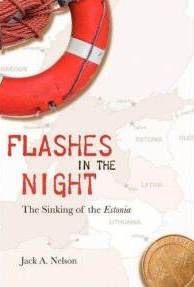This review contains affiliate links, which earn me a small commission when you click and purchase, at no extra cost to you. Thank you for supporting my small business and allowing me to continue providing you a reliable resource for clean book ratings.
In September 1994, almost 900 lives were lost in Europe’s worst peacetime maritime disaster of the century. The MS Estonia, which sailed between Estonia and Sweden, sank in the Baltic Sea during a stormy night, and only 137 people survived.
Author Jack Nelson details the events of that tragic night, during which many were trapped in a ship whose list made it very difficult to escape, and in which those who were able to get out of the ship spent many dark, cold hours waiting for rescue.
The Estonia could transport more than a thousand passengers between Estonia, which was just emerging from Soviet rule, and Sweden. It was a popular quick, cheap vacation for Swedes and a gateway to a new world for Estonians who had been unable to travel for years. The bars, restaurants, dance floors and karaoke room hosted revelers who often partied all night during the overnight 14-hour voyage, and those who didn’t party could sleep in peace in comfortable cabins below deck. On the night of the disaster, there were groups of business people and a large contingent of Swedish police officers as well as a Bible group traveling between the two countries.
The voyage that night was particularly rough, with a storm and huge swells tossing the ship. Seasoned travelers mostly took it in stride, assuming the ship was built solidly enough to weather the storms of a choppy Baltic Sea. Others simply retired to bed early and hoped sleep would help them deal with their upset stomachs. But many knew something wasn’t right when around midnight a metallic grinding sound was followed by the ship starting to tilt steeply. The smartest got up to the top decks quickly, wearing warm clothes.
Within 30 minutes, the large ship was at the bottom of the sea, with many passengers still trapped inside. Those who were strong enough to climb out of the slick hallways and out to the decks either jumped or were washed into the sea, where those who survived found inflated life rafts. Most were not rescued until morning, because nearby ships and helicopters had trouble finding the survivors in the dark or were unable to reach them in the rough storm. Nelson’s recounting of that long, dark night spent in frigid, choppy waters is harrowing. Those who escaped the ship still had to survive hours in desperate conditions until rescue came after dawn. Many died awaiting rescue, some even just moments before it arrived.
Flashes in the Night explores a terrifying night in which hundreds lost their lives in a cold sea, and a minority held on to life despite the odds. The book tells about the people who were on the ship and about what happened that night and recounts the official cause given for the sinking, as well as other theories that dispute the official cause. It’s interesting and heartrending reading, an account of a tragedy few know much about. Those who eat up the stories about the Titanic and who appreciate tales of true adventure will particularly appreciate this book.
Rated: Mild, for some mild language.
Click here to purchase your copy of Flashes in the Night on Amazon.




